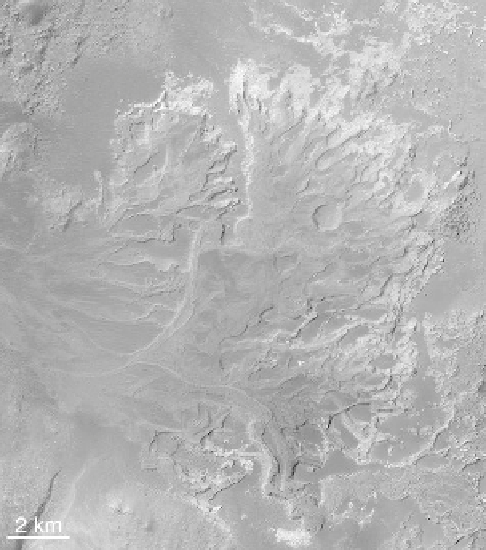Geology Reference
In-Depth Information
Opportunity reached crater Endeavor in 2011 and began
exploration of this 22 km impact structure. Analysis of a
small boulder on the crater rim revealed the presence of
high levels of zinc and bromine, which are considered to
be good indicators of deposition in warm water.
The Phoenix landing site was selected in the north polar
region, Vastitas Borealis. Shallow trenches dug by the
lander
'
s mechanical arm revealed the presence of hard-
as-rock water-ice 5
-
18 cm beneath the surface. Coupled
with the discovery of various salts and minerals, and
observations of active snowfall and frost formation in
late summer, this shows that water clearly plays an impor-
tant role in the chemistry and geology of the polar region.
Data from the Mars Reconnaissance Orbiter show that ice
and water processes also occur in the lower latitudes. For
example, Shane Byrne of the University of Arizona exam-
ined newly formed impact craters and found water-ice that
“
faded
”
with time, the inference being that the impact
penetrated several meters into a zone of relatively clean
ice, which subsequently sublimated as it was exposed to
the atmosphere.
Mars
'
polar regions have long been recognized as dis-
tinctive from the rest of the planet. Sparsely cratered
layered terrains include alternating deposits of dark and
light materials thought to be ice (both carbon dioxide and
water) and dust settled from the atmosphere. Some layers
are less than 1m thick and could represent seasonal or
longer-term cycles perhaps associated with variations in
the position of Mars
'
spin axis. The total thickness of the
south polar ice cap is ~3 km and consists of about 85%
carbon dioxide ice and 15% water-ice. Shallow-depth
radar mapping from the ESA
'
s Mars Express orbiter
reveals the presence of massive buried deposits of carbon
dioxide ice in the south polar layered terrain, as reported
by Roger Phillips et al.(
2011
). If released to the atmo-
sphere during times of Mars
Figure 7.25. This complex delta consists of alluviumdeposited from a
channel that
flowed into Eberswalde crater; overlapping channel
segments and deposits in the delta indicate repeated
ooding events
(NASA PIA04293).
on Mars today are borderline for liquid water, the probable
presence of salts would lower the freezing temperature
and enhance its probability.
Each new mission to Mars has not only provided a
growing body of evidence for the presence of water but
also facilitated the making of estimates of the amount that
might be present. The total amount of water is commonly
expressed as the depth of water that would cover the entire
globe if Mars were a smooth, spherical object. These esti-
mates range from a depth of few meters to nearly 100m.
The Mars Exploration Rovers, Spirit and Opportunity,
revealed evidence for groundwater modi
cation of sur-
face materials from the identi
cation of minerals that
commonly form in association with water, such as the
hydrated iron oxide goethite. The Spirit rover analyzed
outcrops within the Columbia Hills of Gusev crater and
revealed loose, clastic materials and indurated deposits
rich in sulfate and silica. Although several diverse inter-
pretations have been proposed to explain the origins of
these materials, including volcanic pyroclastic emplace-
ment and local fumarolic activity, most ideas require alter-
ation in the presence of water as discussed by Ray
Arvidson and MER colleagues (Arvidson et al.,
2008
).
After a journey of more than 30 km from its landing site,
high obliquity, the atmo-
spheric surface pressure could nearly double, enhancing
aeolian activity and the possibility of there being liquid
water on the surface.
In addition to the polar ice caps, various periglacial
features are seen. For example,
Fig. 7.26
shows irregu-
larly shaped pits in the residual southern carbon dioxide
cap; similar features imaged repeatedly changed shape
with time, which is attributed to the sublimation of ice.
So-called
“
spider terrain
”
is also seen in the south polar
regions. This terrain consists of radial fractures
(Fig. 7.27)
, some of which have associated dark streaks
(Fig. 7.28)
that are interpreted to result from carbon diox-
ide geysers that eject dark rocky material. These are
'



